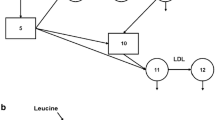Summary
The efficacy of simvastatin in reducing plasma cholesterol is well documented. Other molecules within the apo lipoprotein family, particularly lipoprotein (a) Lp(a), have recently been found to have a predictive and/or causative role in atherosclerosis. Based on these considerations, we studied 15 patients affected by primary hypercholesterolemia to evaluate the effect of simvastatin in Lp(a) and apoprotein plasma levels (A1, B, C2, C3, E), in addition to the classic lipid parameters. Clinical and laboratory parameters were evaluated before therapy, after 12 weeks of therapy, and after 5 weeks of drug withdrawal. Simvastatin therapy produced a significant reduction in total cholesterol (CH) and LDL-CH (p<0.0001), and a significant increase in HDL-CH (p<0.01); no variation was observed in triglyceride (TG) levels. Simvastatin therapy further showed a significant decrease in apoC2 (p<0.05), the apo C2/C3 ratio (p<0.01), and apoE (p<0.01), as well as a significant increase in Lp(a) plasma levels (p<0.05). All of the parameters studied returned to pretreatment values 5 weeks after drug withdrawal; only HDL-CH persisted above the values reached during therapy. Our data agree with those documenting the beneficial effect of simvastatin in greatly decreasing CH and LDL-CH, but point out the need for further studies on the long-term effect of simvastatin on apoprotein molecules, such as on Lp(a), in order to fully establish its role in the secondary prevention of atherosclerosis.
Similar content being viewed by others
References
Kannel WB, Castelli WP, Gordon T. Lipoprotein cholesterol in the prediction of atherosclerotic disease: New perspectives based on the Framingham Heart Study.Ann Intern Med 1979;90:85–91.
Castelli WP, Garrison RJ, Wilson PWF, Abbott RD, Kalousdian S, Kannel WB. Incidence of coronary heart disease and lipoprotein cholesterol levels: The Framingham Heart Study.JAMA 1986;256:2835–2838.
Consensus Conference. Lowering blood cholesterol to prevent heart disease.JAMA 1985;253:2080–2086.
Lipid Research Clinics Program. The lipid research clinics coronary primary prevention trial result. I. Reduction in incidence of coronary heart disease.JAMA 1984;251:351–364.
Gurewich V, Mittleman M. Lipoprotein(a) in coronary heart disease. Is it a risk factor after all?JAMA 1994;271:1025–1026.
Grundy SM. HMGCo A reductase inhibitors for treatment of hypercholesterolemia.N Engl J Med 1988;319:24–32.
Mertz B. Lp(a) joins other serum cholesterol lipoproteins as a risk determinant.JAMA 1989;261:2013–2014.
Ito H, Nalto C, Hayashi H, Kawamura M. Activity of low-density lipoprotein receptors as estimated from concentrations of apolipoprotein B and C-II in serum.Clin Chem 1988;34:11:2224–2227.
Summary of the Second Report of the National Cholesterol Education Program (NCEP) Expert Panel on Detection, Evaluation and Treatment of High Blood Cholesterol in Adults (Adult Treatment of High Blood Cholesterol in Adults (Adult Treatment Panel II).JAMA 1993;269:3015–3023.
Lipid Research Clinic Program.Manual of Laboratory Operations, vol. 1, Lipid and Lipoprotein Analysis. Department of Health, Education and Welfare (National Institutes of Health) publication no. 75-628, Washington, DC: US Government Printing Office, 1974.
Friedewald WT, Levy RJ, Fredrickson DS. Estimation of the concentration of low-density lipoprotein cholesterol in plasma, without use of the preparative ultracentrifuge.Clin Chem 1972;18:499–502.
Molgaard J, von Schenck H, Olsson AG. Effects of simvastatin on plasma lipid, lipoprotein and apolipoprotein concentrations in hypercholesterolemia.Eur Heart J 1988;9:541–551.
Mol MJTM, Erkelens DW, Gevers Leuven JA, Schouten JA, Stalenhoef AFH. Simvastatin (MK-733): A potent cholesterol synthesis inhibitor in heterozygous familial hypercholesterolemia.Atherosclerosis 1988;69:131–137.
Mol MJTM, Erkelens DW, Gevers Leuven JA, Schouten JA, Stalenhoef AFH. Effects of synvinolin (MK-733) on plasma lipids in familial hypercholesterolemia.Lancet 1986;2:936–939.
Bard IM, Luc G, Douste-Blazy P, et al. Effect of simvastatin on plasma lipids, apolipoproteins and lipoprotein particles in patients with primary hypercholesterolemia.Eur J Clin Pharmacol 1989;37:545–550.
Kazumi T, Yoshino G, Okutani T, et al. Effects of simvastatin on plasma lipoproteins and apolipoproteins in Japanese diabetics with hypercholesterolemia. Abstract presented at the 8th International Symposium on Atherosclerosis, Rome, 9–13 October, 1988.
Giudici GA, Stefanoni P, Cuchel M, Cerri MA, Clerichi MG. Effects of simvastatin on total and lipoprotein lipid, apoproteins and plasma Vitamin E in heterozygous familial hypercholesterolemia. Abstract presented at the 8th International Symposium on Atherosclerosis, Rome, 9–13 October, 1988.
Bard JM, Parra HJ, Camare R, et al. A multicenter comparison of the effects of simvastatin and fenofibrate therapy in severe primary hypercholesterolemia with particular emphasis on lipoproteins defined by their apolipoprotein composition.Metabolism 1992;41:498–503.
Rhoads GG, Dahlen G, Berg K, Morton NE, Dannenberg AL. Lp(a) lipoprotein as a risk factor for myocardial infarction.JAMA 1986;256:2540–2544.
Armstrong VW, Cremer P, Eberle E, et al. The association between serum Lp(a) concentrations and angiographically assessed coronary atherosclerosis.Atherosclerosis 1986;62:249–257.
Slunga L, Johnson O, Dahlen GH. Changes in Lp(a) lipoprotein levels during the treatment of hypercholesterolemia with simvastatin.Eur J Clin Pharmacol 1993;43:363–373.
Grainger DJ, Kirschenlohr HL, Metcalfe JC, Weissberg PL, Wade DP, Lawn RM. Proliferation of human smooth muscle cells promoted by lipoprotein(a).Science 1993;260:1655–1658.
Utermann G. The mysteries of lipoprotein(a).Science 1989;246:904–910.
Author information
Authors and Affiliations
Rights and permissions
About this article
Cite this article
Sampietro, T., Galetta, F. & Bionda, A. Behavior of Lp(a) and apoproteins (A1, B, C2, C3, E) during and after therapy with simvastatin. Cardiovasc Drug Ther 9, 785–789 (1995). https://doi.org/10.1007/BF00879872
Received:
Accepted:
Issue Date:
DOI: https://doi.org/10.1007/BF00879872




